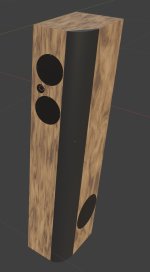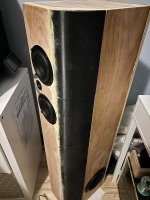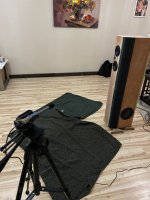This is my first time posting in this forum - I hope one of you kind folks is willing to take on my case and help me know where I've gone wrong.
Brief backstory: after a school project, my family had a set of Dayton Audio TCP115-8 mid woofers laying around, so I proposed to my two older sons that we make loudspeakers. We have turned this process into a design competition between the two of them, with each making a pair of loudspeakers, with my support on both projects. Both have selected floor standing 3-way designs. For one of the pairs, we have now reached the stage of a finalized enclosure and frequency response measurements to prepare the crossover design. Pictures of the design, current build, and testing setup are attached.
Now, the problem. In our first round of frequency response measurements, we used the following setup:

Later on, while considering how to improve power output for the less sensitive mids and woofer, I realized we have a Focusrite Scarlett 2i2 audio interface, which I probably should have been using from the beginning. I tested it during our measurement sessions for the mids and woofer, and was able to get much higher output levels, and reasonable measurements from 20Hz - 2kHz. Satisfied that this was the better setup, we went back to re-run the tests on the tweeter. The setup was now like this:

We had hoped that the audio interface would give us higher-quality information, but I sincerely hope this measurement is not the more accurate of the two! As mentioned above, we tried line out and headphone out from the Scarlett, we tried Java drivers and ASIO drivers. We tried 80dB, 86dB, and 92dB peak output. All measurements with the Scarlett with all scenarios just mentioned gave the same results with the steady and dramatic high-end roll-off.
Apologies for the long read. If you are still with me at this point, the question I have is: what is wrong with either or both of my setups that would be introducing error? Is one of these more likely than the other to be the "most correct" or "least inaccurate" set of data? We will be loading the measurements into VituixCAD for crossover design work in the next step of our design and want the best data we can manage to gather with the equipment we have available.
Brief backstory: after a school project, my family had a set of Dayton Audio TCP115-8 mid woofers laying around, so I proposed to my two older sons that we make loudspeakers. We have turned this process into a design competition between the two of them, with each making a pair of loudspeakers, with my support on both projects. Both have selected floor standing 3-way designs. For one of the pairs, we have now reached the stage of a finalized enclosure and frequency response measurements to prepare the crossover design. Pictures of the design, current build, and testing setup are attached.
Now, the problem. In our first round of frequency response measurements, we used the following setup:
- Lenovo Legion Pro 7i 16IRX8H laptop
- miniDSP UMIK-1 USB microphone, plugged directly to laptop via USB, with calibration file
- REW V5.31 software, Java drivers, output via laptop Realtek headphone output
- Simple Pyle PTA62BT amplifier, using Aux input from laptop headphone output
- Mic 1.2m from dome of tweeter, vertically on-axis with tweeter, 3ms gate, 1/24 smoothing, measurements every 10 degrees from -90 deg to +90 deg
- Tweeter being tested in this speaker is Dayton Audio ND20FB-4
Later on, while considering how to improve power output for the less sensitive mids and woofer, I realized we have a Focusrite Scarlett 2i2 audio interface, which I probably should have been using from the beginning. I tested it during our measurement sessions for the mids and woofer, and was able to get much higher output levels, and reasonable measurements from 20Hz - 2kHz. Satisfied that this was the better setup, we went back to re-run the tests on the tweeter. The setup was now like this:
- Lenovo Legion Pro 7i 16IRX8H laptop
- miniDSP UMIK-1 USB microphone, plugged directly to laptop via USB, with calibration file
- REW V5.31 software, both Java and ASIO drivers tested for the output
- Simple Pyle PTA62BT amplifier, both headphone and line outs tested from Scarlett
- Mic 1.2m from dome of tweeter, vertically on-axis with tweeter, 3ms gate, 1/24 smoothing, measurements every 10 degrees from -90 deg to +90 deg
- Tweeter being tested in this speaker is Dayton Audio ND20FB-4
We had hoped that the audio interface would give us higher-quality information, but I sincerely hope this measurement is not the more accurate of the two! As mentioned above, we tried line out and headphone out from the Scarlett, we tried Java drivers and ASIO drivers. We tried 80dB, 86dB, and 92dB peak output. All measurements with the Scarlett with all scenarios just mentioned gave the same results with the steady and dramatic high-end roll-off.
Apologies for the long read. If you are still with me at this point, the question I have is: what is wrong with either or both of my setups that would be introducing error? Is one of these more likely than the other to be the "most correct" or "least inaccurate" set of data? We will be loading the measurements into VituixCAD for crossover design work in the next step of our design and want the best data we can manage to gather with the equipment we have available.
Attachments
It almost looks like the second (lower) plot included the effect of a treble tone control turned all the way down, or a lowpass filter was enabled. For example, if the crossover was wired wrong and the tweeter is getting the woofer filter.
If the crossover is used, bypass it. Otherwise, look for some software filter or the amp tone control as the culprit.
If the crossover is used, bypass it. Otherwise, look for some software filter or the amp tone control as the culprit.
Give or take a bit, the difference in the data is approx. 5-6db drop per octave in the second measurement.
I dont know what the calibration data file looks like but has it been applied? I wouldn't expect a Cal file to be that drastic but its worth checking.
Also worth a check is the type of stimulus used for the first and second measurements, where they the same type. I am not familiar with the software so had to ask. Maybe as a sanity check apply the stim to the Sound card loop and verify you have a nice flat line when measured.
I dont know what the calibration data file looks like but has it been applied? I wouldn't expect a Cal file to be that drastic but its worth checking.
Also worth a check is the type of stimulus used for the first and second measurements, where they the same type. I am not familiar with the software so had to ask. Maybe as a sanity check apply the stim to the Sound card loop and verify you have a nice flat line when measured.
Can you play music from the computer through the speaker? Start there. Don't play through the tweeter, just a woofer!
I use the CD input on my AVR. You could connect a CD player, and set a normal soft volume. Then try the computer using the same input.
I would sweep only a woofer, until you get the measurement setup SPL where it should be. Put a cap in series with the tweeter, and maybe even the woofer till the SPL is appropriate.
Check the output signal in REW. There's a L and a R.
Also check the sweep level. I think default is -20dB. Carefully increase this. I use -10dB frequently, and a known volume setting on my AVR.
A couple of screen shots of REW before a sweep starts could show something out of place.
I use the CD input on my AVR. You could connect a CD player, and set a normal soft volume. Then try the computer using the same input.
I would sweep only a woofer, until you get the measurement setup SPL where it should be. Put a cap in series with the tweeter, and maybe even the woofer till the SPL is appropriate.
Check the output signal in REW. There's a L and a R.
Also check the sweep level. I think default is -20dB. Carefully increase this. I use -10dB frequently, and a known volume setting on my AVR.
A couple of screen shots of REW before a sweep starts could show something out of place.
Last edited:
Did you check if the Focusrite had some kind of signal processing switched on? This happened to others.
Thank you all for your inputs. Your observations that the high frequency attenuation looks like a steady slope caused by some kind of EQ or filter has me on the right path I think. I can confirm the Focusrite doesn't have any tone controls, physically, or in the software (screenshot of the settings page of the Focusrite software below).

However, I realized for the first time that the amp I am using does have tone controls. 🤦♂️ Confusingly, the tone controls are both at 12 o'clock, indicating they theoretically shouldn't be applying any filter. (According to the manual, the mysteriously labeled "Music" knob is actually master volume, not a tone control.)

One setup detail that escaped my notice in my initial post is that I was using a TRS cable in my Focusrite Scarlett setup, into the Mic inputs on the front panel of the amp. When I used the laptop headphone output, I was using a 1/8" to RCA into the Aux input of the amp. So my working theory for now is that the mic inputs of the amp are affecting the response. I have ordered a TRS>RCA cable so I can try running the Scarlett to the Aux input to see if that solves the issue. I'll report back if solved.
Thank you all so much for your suggestions!
However, I realized for the first time that the amp I am using does have tone controls. 🤦♂️ Confusingly, the tone controls are both at 12 o'clock, indicating they theoretically shouldn't be applying any filter. (According to the manual, the mysteriously labeled "Music" knob is actually master volume, not a tone control.)
One setup detail that escaped my notice in my initial post is that I was using a TRS cable in my Focusrite Scarlett setup, into the Mic inputs on the front panel of the amp. When I used the laptop headphone output, I was using a 1/8" to RCA into the Aux input of the amp. So my working theory for now is that the mic inputs of the amp are affecting the response. I have ordered a TRS>RCA cable so I can try running the Scarlett to the Aux input to see if that solves the issue. I'll report back if solved.
Thank you all so much for your suggestions!
Pretty possible. Mic inputs s#&ck almost all of the time, at high gains they seldomly measure straight.So my working theory for now is that the mic inputs of the amp are affecting the response
Do a loopback test: connect a pre out to the aux in of the audio interface. Or use a 20 dB pad and measure on the speaker terminals (you need something like that to measure impedance anyway). Checking the measurement chain before measuring a DUT is quintessential.
You could bring the microphone closer to the speaker in this case. Take about 3 or 4 times the baffle width as measurement distance to incorporate the effect of it. Later on you could check on something like 2 meter, but that would have to be ground plane measurement or lifting speaker and microphone high up in the air.
The real catch is in the delay the internal signal processing of the Scarlett comes with. You need a trustworthy time reference.
Sound card loop and verify you have a nice flat line when measured
Do a loopback test: connect a pre out to the aux in of the audio interface
always verify your your setup to ensure you have a flat amplitude/phase response
use line-in and line-out connections.
It's actually a good idea to test the linearity of the mic preamp on higher gains. Although you likely won't need it at high gain, cheaper mic amps found in audio interfaces don't always manage to stay straight. Use (again) a voltage divider of some 20dB from line out to mic in (if you're picky, use balanced line out-balanced mic in). Reduce line out level to zero and turn gain on the mic pre to anything near max. Then adjust line out level til you have enough for measurement and perform loopback.use line-in and line-out connections.
Thank you all for your help and patience. I see, as I suspected, my limited understanding of the electronics at my disposal is a handicap, but I'm slowly making progress.
Following advice here, and with the guide built into REW, I was able to finally calibrate the Focusrite (loopback with TRS cable from L line out to input 1). Thankfully, that calibration exercise did indicate that the device is pretty flat (0.1dB down at 20Hz and 0.05dB up at 19kHz):

This left the amplifier mic input section as the culprit. The behavior was unexpected because none of the physical controls on the amp indicating any filters were being applied, and the manual made no mention of any filters on the mic inputs, yet you all saw quite clearly in the measurements that a filter was involved:
There is in fact a 6dB/octave low pass starting at about 3kHz in the tweeter measurements. And, even though I didn't post my woofer measurements in my initial post, there was also a 12dB/octave high pass apparent in that data starting at around 80Hz.
So, I bought a new cable that enabled me to run the line out of the Focusrite into the aux input of the amplifier. This seemed to resolve the issue I was having! Apparently, this silly amp does have an undisclosed high and low shelf filter on the mic input.
I re-ran all my measurements now and feel satisfied enough with the outcome that I will move to design in VituixCAD with this data.
Tweeter:

Mids (near field measurement of one driver cone merged to on-axis far field measurement at 480Hz, BSC applied):

Woofer (summation of cone and port, port reduced by 8dB, tuning looks 4Hz lower than intended):

Do a loopback test: connect a pre out to the aux in of the audio interface. Or use a 20 dB pad and measure on the speaker terminals (you need something like that to measure impedance anyway). Checking the measurement chain before measuring a DUT is quintessential.
Following advice here, and with the guide built into REW, I was able to finally calibrate the Focusrite (loopback with TRS cable from L line out to input 1). Thankfully, that calibration exercise did indicate that the device is pretty flat (0.1dB down at 20Hz and 0.05dB up at 19kHz):
This left the amplifier mic input section as the culprit. The behavior was unexpected because none of the physical controls on the amp indicating any filters were being applied, and the manual made no mention of any filters on the mic inputs, yet you all saw quite clearly in the measurements that a filter was involved:
It almost looks like the second (lower) plot included the effect of a treble tone control turned all the way down, or a lowpass filter was enabled. For example, if the crossover was wired wrong and the tweeter is getting the woofer filter.
If the crossover is used, bypass it. Otherwise, look for some software filter or the amp tone control as the culprit.
Give or take a bit, the difference in the data is approx. 5-6db drop per octave in the second measurement.
There is in fact a 6dB/octave low pass starting at about 3kHz in the tweeter measurements. And, even though I didn't post my woofer measurements in my initial post, there was also a 12dB/octave high pass apparent in that data starting at around 80Hz.
So, I bought a new cable that enabled me to run the line out of the Focusrite into the aux input of the amplifier. This seemed to resolve the issue I was having! Apparently, this silly amp does have an undisclosed high and low shelf filter on the mic input.
I re-ran all my measurements now and feel satisfied enough with the outcome that I will move to design in VituixCAD with this data.
Tweeter:
Mids (near field measurement of one driver cone merged to on-axis far field measurement at 480Hz, BSC applied):
Woofer (summation of cone and port, port reduced by 8dB, tuning looks 4Hz lower than intended):
A better microphone mount seems mandatory to me. This one messes up measurements with reflections.I would suggest using gated measurements for the sims.
- Home
- Loudspeakers
- Multi-Way
- Which of My Tweeter Response Curves is Least Inaccurate?



 Moved to Multi-Way
Moved to Multi-Way